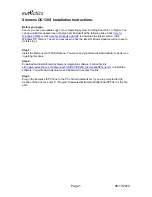
Section 5. Split
3.
when an interval count is met
When the Trigger on Stop Condition (or F option) is used, any time series data
defined in the Select line is output each time the Stop Condition is met. Refer
to Section 5.3.1.4.2 for more information on the Trigger on Stop Condition.
Results which are output at the end of a file or a range of data are referred to as
Final Summaries. A typical select line that would produce a Final Summary is:
1,2,3,4,Avg(4)
This line would output values for elements 1 through 4 each time an array was
output. Additionally, an average value for element 4 would be calculated for
the entire file and output as the last line of data in the output file.
1,2,3,4,Avg(4;24)
This line would output values for elements 1 through 4 each time an array was
output, and an average value for element 4 would be calculated every 24
th
array and output as an additional column in the file. An additional summary
would occur for an Interval Count if the count was not evenly divisible into the
number of output arrays present in the Input File. The summary, in this case,
is calculated from an incomplete interval count.
The date( ) function can be used for the interval in a time series function to
produce monthly output. Refer to the Monthly summary example in Section
5.3.1.12.
When Date and Edate are used within other functions they must
be used with the older format Date(doy;y) and Edate(doy;y)
instead of using the extended date functions. For example
AVG(1;Date(2;2002.0)). The decimal is needed to indicate a
fixed number. Numbers without the decimal are interpreted as
element IDs.
NOTE
The interval count in a Time Series Function is optional and does not require a
decimal point. To determine the interval, Split counts the number of arrays
which meet the specified conditions (Stop, Start, and Copy). If the time
synchronize function is enabled, the Time Series functions remain
synchronized to the starting time even if a complete array is missing from the
input data. When elements are missing, the Time Series calculations are based
on the actual number of elements found.
Semicolons are used in Time Series functions to separate the elements or
expressions from the count which determines the interval. SmplMax and
SmplMin require two elements separated by a semicolon. The first is checked
for a maximum or minimum, while the second is sampled on the maximum or
minimum.
The following set of weather data from Mt. Logan in northern Utah gives a
total of seven elements each hour. This Field Formatted output, with title and
column headers, was generated by Split. These data are used in the following
examples of Time Series functions.
5-27
Summary of Contents for PC400
Page 2: ......
Page 16: ...Section 1 Introduction 1 6...
Page 18: ...Section 2 System Requirements 2 2...
Page 46: ...Section 4 The PC400 Main Screen 4 24...
Page 49: ...Section 5 Split 5 3...
Page 82: ...Section 5 Split 5 36...
Page 114: ...Section 6 View 6 14...
Page 132: ...Section 7 Short Cut Program Generator 7 18...
Page 188: ...Section 9 Datalogger Program Creation with CRBasic Editor 9 30...
Page 230: ...Appendix B Table Based Dataloggers B 12...
Page 249: ......
















































